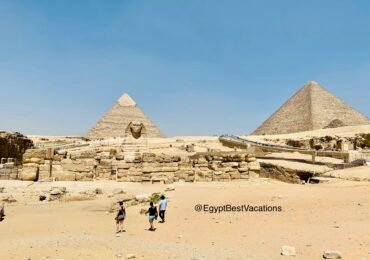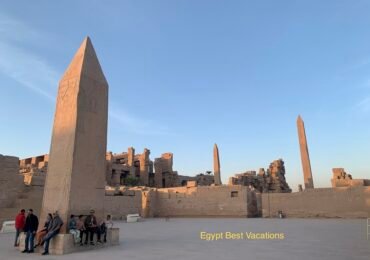Egypt’s history is a captivating tale. It spans over 5,000 years, making it one of the world’s oldest civilizations. The Nile River, a life-giving artery, played a crucial role. It nurtured the development of ancient Egyptian civilization. Pharaonic Egypt is renowned for its monumental architecture. The pyramids and temples are a testament to this era. The Great Pyramid of Giza, one of the Seven Wonders of the Ancient World, is a prime example.
Hieroglyphics, the writing system of ancient Egypt, were used for religious texts and inscriptions. This unique script is a window into the culture and beliefs of the time. Religion was central to ancient Egyptian life. They practiced a polytheistic religion with a pantheon of gods and goddesses. The concept of the afterlife was significant, leading to elaborate burial practices. Pharaohs, considered divine rulers, played a central role. They were pivotal in both governance and religion.
Egypt’s history is divided into several periods. The Old, Middle, and New Kingdoms are the three major periods in ancient Egyptian history. Each era has its unique characteristics and contributions. Egypt was also a land of conquest. It was ruled by various foreign powers, including the Persians, Greeks, and Romans. Each left their mark on the country’s history and culture.
The 1952 revolution was a turning point. It led to the end of the monarchy and the establishment of a republic. This event marked the beginning of modern Egypt. The 2011 revolution was another significant event. It was part of the Arab Spring, leading to the ousting of President Hosni Mubarak.
Egypt’s rich cultural heritage continues to draw people. It is a significant draw for tourism and study. This article aims to provide a comprehensive overview of Egypt’s history, from its ancient beginnings to the modern era.
Join us as we journey through time, exploring the fascinating history of Egypt.
The Dawn of Civilization: Prehistoric to Early Dynastic Egypt
Egypt’s history began long before the first pharaohs. The prehistoric period saw the rise of early communities along the Nile. These communities relied heavily on the river’s annual flooding, which enriched the soil. Agriculture flourished due to the fertile Nile Valley. Farming became a cornerstone of early Egyptian society. As a result, settlements grew and developed complexity over time.
By around 3100 BCE, Egypt transitioned into the Early Dynastic Period. This era marked the unification of Upper and Lower Egypt. Legend attributes this unification to King Menes, also known as Narmer. During this period, the concept of kingship emerged. The pharaoh became the central figure in Egyptian society. These early rulers were seen as both kings and gods.
Hieroglyphics, Egypt’s ancient writing system, began to take shape. This development was crucial for administration and record-keeping. It laid the foundation for the complex civilization that followed. Egypt’s early history set the stage for its illustrious future. The groundwork laid in these formative years was pivotal. It provided the framework for the advancement seen in later periods.
The Age of Pyramids: The Old Kingdom

Pharaonic power became centralized, and the state witnessed significant administrative advances. The vizier was established as the right hand of the pharaoh. This allowed for efficient management of vast resources and labor forces.
Religion and society were deeply intertwined during this time. The concept of the divine pharaoh, who acted as a mediator between gods and people, was solidified. Temples and art dedicated to the gods proliferated across the land.
Economic prosperity helped support these grandiose projects. Agriculture, particularly along the Nile Delta, thrived due to advanced irrigation. As a result, Egypt experienced a period of peace and cultural blossoming.
Turmoil and Stability: First Intermediate Period and Middle Kingdom
The First Intermediate Period, lasting from 2181 to 2055 BCE, brought challenges to Egypt. This era followed the collapse of centralized power and was marked by political instability. Local rulers emerged, each vying for control over fragmented territories. Despite the chaos, this period saw cultural innovation. Art and literature flourished as regional dynasties sought to legitimize their authority. New styles and expressions emerged, reflecting the complex societal changes.
Eventually, the Middle Kingdom arose around 2055 BCE, restoring order and unity. Pharaoh Mentuhotep II reunited Egypt and established the 11th Dynasty. With Thebes as the center, Egypt embarked on a new era of prosperity and cultural revival.
During the Middle Kingdom, trade expanded beyond Egypt’s borders. Expeditions extended to regions like Nubia and the Levant, enriching the kingdom. This economic growth fostered advancements in architecture, with temple complexes and fortifications emerging.
Social structures also evolved in the Middle Kingdom. The role of provincial governors became more defined, enhancing local governance. Literature, such as “The Tale of Sinuhe,” reflected evolving themes of leadership and morality, capturing the spirit of the time.
The Height of Power: The New Kingdom
The New Kingdom era, spanning from 1550 to 1070 BCE, marked Egypt’s apex. This period was characterized by military prowess and grand architectural endeavors. The 18th Dynasty witnessed Egypt becoming an imperial power. Pharaohs such as Thutmose III extended Egypt’s influence. His military campaigns into Nubia and Asia broadened Egypt’s borders. These conquests brought immense wealth and fostered a period of opulence.

The New Kingdom also saw significant religious developments. The religious reforms of Akhenaten, who promoted worship of the sun god Aten, introduced monotheistic tendencies. These changes, though short-lived, left a lasting impact.
Ultimately, the New Kingdom declined due to internal strife and external pressures. Successive pharaohs faced challenges maintaining dominance, leading to gradual weakening. Despite this, the artistic and cultural legacy of this period endures, symbolizing Egypt’s historic zenith.
Decline and Foreign Rule: Third Intermediate Period to Late Period
The Third Intermediate Period, roughly 1069 to 664 BCE, was marked by fragmentation. Egypt faced internal divisions with power split between pharaohs in the north and priestly rulers in Thebes. Foreign influence surged during this chaotic time. The Libyans and Nubians intermittently held sway over Egypt. The 25th Dynasty, originating from Nubia, eventually reunified the realm for a short period.
Following this era, the Late Period began. Assyrian and later Persian conquerors imposed their control over Egypt. These external rulers brought Egypt’s political autonomy to an end. Despite these challenges, Egyptian culture persisted. The dynasties maintained traditional religious practices and monumental architecture continued. Temples and tombs from this period still reflect the enduring cultural identity of Egypt.
The Persian period ended with Alexander the Great’s conquest. His arrival in 332 BCE ushered in a new chapter, setting the stage for Ptolemaic rule. This transition marked a complex blend of continuity and change for Egypt.
The Greek Influence: Ptolemaic Egypt
The Ptolemaic Dynasty began with Alexander the Great’s conquest. He founded the city of Alexandria, which became a cultural hub. This city boasted the renowned Library of Alexandria and the towering Lighthouse of Pharos. Under Ptolemaic rule, Greek influence intertwined with native traditions. The dynasty spanned from 305 to 30 BCE, leaving a lasting impact. Hellenistic culture flourished alongside ancient Egyptian customs during this period.
Cleopatra VII, the last of the Ptolemies, is a towering figure from this era. Her alliances and affairs with Julius Caesar and Mark Antony are legendary. Cleopatra’s reign ended with her defeat and the annexation of Egypt by Rome.
Despite foreign rule, Egyptians maintained religious practices and monumental structures. Temples dedicated to traditional deities were constructed, reflecting this cultural synthesis. The influence of Greek art and architecture permeated these grand buildings.
The Ptolemaic period was a time of vibrant exchange and adaptation. Greek and Egyptian communities coexisted, creating a unique cultural landscape. This fusion set the stage for the next chapter of Egyptian history under Roman rule.
Under the Eagles of Rome: Roman and Byzantine Egypt
When Cleopatra VII’s reign ended, Egypt became a Roman province. This marked the beginning of a new era in Egyptian history. Roman rule ushered in significant political and cultural changes. Roman Egypt was a vital agricultural center for the empire. The Nile’s fertile lands provided grain to support Rome’s population. This economic importance made Egypt strategically crucial to Roman interests.
During this period, Christianity began to spread across the region. It transformed the religious landscape as the new faith gained followers. This shift led to the decline of traditional Egyptian religious practices. The Byzantine Empire later took control after Rome’s decline. Byzantine rule maintained Roman influence while further spreading Christianity. The Coptic Church emerged during this time, becoming a major institution.
Although under foreign rule, Egypt continued to be a cultural melting pot. The blend of Roman, Byzantine, and native traditions shaped the society. This period set the stage for the upcoming Arab conquest and transition to Islamic Egypt.
The Rise of Islam and Arab Rule
In the 7th century, Arab forces arrived in Egypt. Their presence marked the beginning of a new era in Egyptian history. The Islamic conquest brought significant cultural and religious changes. Amr ibn al-As led the Muslim conquest of Egypt. This pivotal event occurred in 641 AD. Under his leadership, the city of Fustat was established as the capital.
Islam quickly became the dominant religion across the region. It transformed social and political structures. Many Egyptians embraced the new faith, gradually integrating Islamic practices into daily life. Cairo emerged as a major center of culture and commerce. The Fatimid Caliphate, a Shia Islamic dynasty, founded the city in 969 AD. It soon became a hub of learning and civilization.
The Islamic period saw the rise of remarkable architecture and scholarship. Institutions like Al-Azhar Mosque demonstrated Egypt’s role as a cultural leader. Over time, Egypt’s Islamic identity strengthened, shaping its modern trajectory.
Ottoman Control and the French Expedition
The Ottoman Turks conquered Egypt in 1517. This marked the beginning of Ottoman rule. Egypt became a province within the vast Ottoman Empire. The Ottomans ruled Egypt with indirect control. Local Mamluk leaders retained some power. These dynamics often led to political tension and struggle.
Throughout Ottoman rule, Egypt served as an important territory. Its strategic position connected the Mediterranean with the Red Sea. This ensured the flow of goods and resources.
Napoleon’s expedition in 1798 challenged Ottoman authority. His invasion aimed to disrupt British trade routes. The French campaign sparked a new era of European interest in Egypt. Despite initial successes, the French faced resistance. Both Ottoman and British forces eventually expelled them by 1801. This brief period of French control left a lasting impact on Egypt’s cultural and political development.
The British Occupation and the Path to Independence
Egypt’s strategic location has always been key. In the late 19th century, British interests focused heavily on Egypt. The Suez Canal was the main reason for this attention. In 1882, Britain took control of Egypt. The occupation was initially meant to be temporary. However, British control persisted for many decades.
Under British rule, Egyptians faced many economic and social changes. Infrastructure improvements and modernization were promoted. Yet, these developments mainly benefited British interests.
The early 20th century saw rising Egyptian nationalism. The 1919 revolution was a pivotal moment. It was a powerful response to British occupation and control. Finally, in 1922, Egypt gained nominal independence. However, true independence came gradually, with continued British influence. By 1952, a new era was about to begin, propelling Egypt toward full sovereignty and reshaping the nation’s future.
Revolution and Republic: Egypt After 1952
The year 1952 marked a significant turning point in Egyptian history. A revolutionary movement arose, led by the Free Officers. Gamal Abdel Nasser emerged as a key leader. The revolution ended the long-standing monarchy. King Farouk was forced into exile. This event marked the birth of the Egyptian republic.
Nasser became Egypt’s first president, focusing on modernization and development. Nationalizing the Suez Canal in 1956 was his boldest move. This act heightened Egypt’s profile on the world stage. Nasser’s policies emphasized Arab unity and socialism. He initiated land reforms and industrialization projects. His era brought significant social and economic transformation.
Yet, challenges persisted, with periods of tension and conflict. Nasser’s successors continued his legacy in various ways. They navigated Egypt through regional conflicts and internal strife, cementing the nation’s identity as a modern republic.
The 2011 Revolution and Its Aftermath
The 2011 revolution in Egypt was a pivotal event in the nation’s modern history. It was part of the larger Arab Spring movement. Many Egyptians took to the streets to demand change. Protests were driven by a desire for democracy and freedom. President Hosni Mubarak’s long rule came to an end. After decades in power, Mubarak resigned, marking a new era for Egypt.
The revolution’s aftermath was complex and challenging. Egypt held its first free presidential elections. Mohamed Morsi, representing the Muslim Brotherhood, was elected president. However, political instability continued to plague the nation. The military intervened again in 2013. President Morsi was removed from power, leading to further unrest and divisions.
Despite the turmoil, the revolution brought significant political changes. It sparked debates about governance, identity, and rights in Egypt. These discussions continue to shape the country’s path forward, as it seeks stability and progress in a rapidly changing world.
Modern Egypt: Challenges and Progress
In recent years, Egypt has faced several challenges on its path toward progress. Political shifts have created both instability and opportunities. Governance remains a crucial area of focus. The economy has seen highs and lows, influenced by global and local factors. Infrastructure development is ongoing, with projects like the new capital city. Nonetheless, economic reforms are necessary to ensure sustainable growth.
Social issues, such as education and healthcare, demand attention. The government is striving to improve quality and accessibility in these sectors. Public services are key to enhancing everyday life for Egyptians. Cultural and historical tourism remains a cornerstone of the economy. Egypt’s rich heritage attracts millions of visitors annually. Preserving and promoting this heritage is vital for future generations.
Despite obstacles, progress is visible in various aspects of modern Egyptian life. Technology and innovation are becoming more significant. Egypt is slowly carving a path towards a more prosperous and stable future.
Conclusion: The Legacy of Egyptian History
The history of Egypt is a vast tapestry woven with threads of ancient and modern influences. From the grandeur of the pyramids to the complexities of contemporary politics, Egypt’s past is both profound and dynamic. Its impact on the world is undeniable.
Egypt’s journey through history reflects cycles of power, innovation, and cultural exchange. Each era, from the Pharaonic to Islamic periods, has added unique elements to its identity. These legacies influence not only Egypt but the broader global heritage.
Today, Egypt’s historical narrative continues to be written as it navigates present-day challenges and opportunities. Its enduring influence and resilient spirit inspire a deep respect and fascination. Understanding Egypt’s past offers vital lessons and enriches our appreciation of its role in the world.

